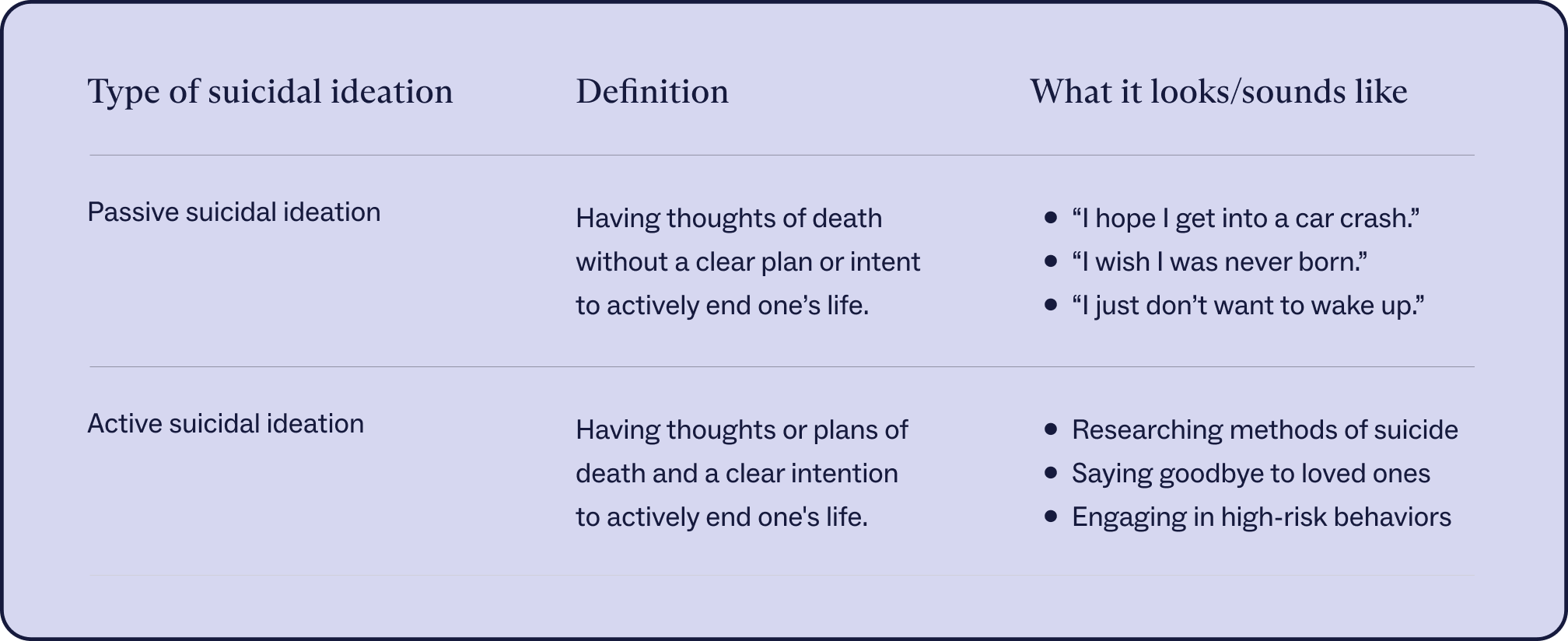
Table of Contents
Passive Suicidal Ideation vs Active Suicidal Ideation: What’s the Difference

Written By: Alex Bachert, MPH

Clinically Reviewed By: Dr. Don Gasparini
April 11, 2024
6 min.
Learn how to recognize suicidal thoughts and feelings so that you can improve your mental health and support others.
Learn more about our Clinical Review Process
Table of Contents
Trigger warning: Suicide. If you’re experiencing suicidal thoughts or are in danger of harming yourself, this is a mental health emergency. Contact The National Suicide Prevention Lifeline 24/7 by calling or texting 988.
Suicide is a serious public health concern for youth in the United States, with data pointing to suicide as the second leading cause of death among adolescents and young adults. It’s also a complex topic, with health experts still seeking effective solutions for how to reduce rates of suicidal thoughts and behaviors.
One idea is to spend more time talking and educating people about suicide. In fact, research shows that discussing suicide can decrease suicidal ideation, defined as thoughts of ending one’s life, and even improve mental health among people seeking treatment. “We want people to talk about suicide because if they talk about it, we have a better chance of helping them,” said Sam Adams, Charlie Health’s Clinical Director. “Suicide prevention starts with talking about suicide.”
Part of the process of raising awareness around suicide is better education about how it affects people, including the difference between passive suicidal ideation and active suicidal ideation. Below, we review common warning signs for both passive and active suicidal ideation, as well as the most effective treatments for improving mental health symptoms.

Healing from suicidal thoughts is possible
We offer intensive mental health support for suicidal thoughts.
Passive suicidal ideation vs active suicidal ideation
Suicidal ideation is a broad term that describes a range of contemplations, wishes, and preoccupations with death and suicide. It’s often divided into two categories: passive suicidal ideation and active suicidal ideation.

Passive suicidal ideation refers to having thoughts of death without any specific plans to act on those thoughts. “Passive suicidal ideation can occur when an individual no longer has the motivation to live but does not have a clear plan to take their life,” according to Charlie Health Primary Therapist Meghan Jensen, LPC. For example, someone with passive suicidal ideation may have a suicidal thought like, “I just don’t want to wake up” or “I wish I could just disappear,” she explained.
Active suicidal ideation, on the other hand, is when someone is actively thinking, planning, or preparing to end their own life. Both types of suicidal ideation involve thoughts of death, but only active suicidal ideation includes defined plans or intentions to take your own life.
“Suicidal ideation encompasses a spectrum of experiences [and] how suicidal ideation presents can vary widely even within passive or active thoughts,” said Claire Streeter, PMHNP, ARNP, a Psychiatric Mental Health Nurse Practitioner with Charlie Health. She explained that hopeless thoughts — like wanting to go to sleep and not wake up — are examples of passive suicidal ideation. On the other hand, creating a suicide plan or having an inclination to act on suicidal thoughts are characterized as active thoughts.
Passive suicidal ideation
Active suicidal ideation
- Thoughts of death without a specific plan to act on those thoughts
- General hopeless thoughts
- Treatment usually does not involve hospitalization
- Thoughts of death with a specific plan to act on those thoughts
- Expressing a desire to commit suicide
- Treatment may involve hospitalization
Signs of suicidal ideation
Learning how to identify signs of suicidal ideation is an important step in protecting people who are struggling with their mental health. Signs and symptoms may vary from person to person, which means it’s not always easy to recognize when someone is struggling with suicidal thoughts.
For example, Streeter says that passive suicidal ideation can present as very general hopeless thoughts, which not everyone recognizes as specifically suicidal thoughts. “Erring on the side of caution is best,” she says. “If someone is reporting thoughts such as wanting to disappear, wishing something would happen to them that might cause them harm, or anything else that implies they are having thoughts of not wanting to be alive, it is best to refer them for further evaluation with a mental health provider.” Below, some other common warning signs for passive and active suicidal ideation.
Signs of passive suicidal ideation:
- Engaging in risky or reckless behavior
- Expressing feelings of extreme sadness, hopelessness, isolation, rejection, or apathy
- Withdrawing or self-isolating
- Change in sleep patterns
- Depression or mood swings
- Giving away meaningful personal possessions
- Scars or other visible signs of self-harm
- Anxiety, irritability, or aggression
- Increased use of drugs or alcohol
- Researching or seeking out objects to assist in suicide, such as prescription drugs, dangerous substances, and guns
- Saying goodbye to loved ones

Signs of active suicidal ideation:
- Active suicidal thoughts
- Talking about death, dying, or thoughts of suicide
- Expressing a desire to commit suicide, including explicit statements like “I want to take my life” or other suicidal behavior
- Actively seeking out ways to commit suicide, such as collecting pills or obtaining a weapon
- Giving away personal items
- Sudden and significant changes in mood or behavior
- Social withdrawal
Do passive and active suicidal ideation require similar treatment approaches?
If you’re experiencing suicidal thoughts, intrusive thoughts, or suicidal behaviors, it’s important to see a mental health professional. Whether it’s passive ideation or active ideation, treatment begins with an initial assessment and establishing safety. From there, treatment options vary based on each person’s health history, risk factors, and unique needs.
“The best treatment approach is individualized based on the person, so it would take into account more than just the ideation at that time. It considers personal and family psychiatric history, environmental circumstances, and more,” said Streeter. “Sometimes those with more active suicidal ideation will need more intensive treatment, or in some cases hospitalization, to ensure safety while they are receiving psychotherapy and medication management services,” she added. Here are several leading methods for managing suicidal ideation.

1. Psychotherapy (aka talk therapy)
“Regardless of the type of ideation, psychotherapy is recommended,” said Streeter. Research shows that cognitive behavioral therapy (CBT) and dialectical behavior therapy (DBT) are two of the most effective therapeutic techniques for people with suicidal ideation or suicide attempts. Group therapy is another effective treatment option for youth struggling with suicidal ideation, as it provides social support and a chance to develop healthier coping mechanisms and emotional regulation.
2. Psychiatric medication
In some cases, medication can be used to help manage suicidal ideation or co-occurring mental health conditions that may be contributing to suicidal thoughts. This varies by person, so it’s best to speak with a therapist or other mental health professional to see if psychiatric medication is an option for your treatment needs.
3. Plan for emergencies
If you’re struggling with passive suicidal thoughts or active suicide ideation, know that help is always available. The following suicide prevention organizations are available to support people during their most challenging moments.
- The National Suicide Prevention Lifeline: Call or text 988
- The Crisis Text Line: Text “HOME” to 741741
- SAMHSA’s National Helpline: Call 1-800-662-HELP (4357)
- The National Alliance on Mental Illness HelpLine: Call 1-800-950-NAMI (6264) or text “HelpLine” to 62640
4. Practice self-care
If you’re experiencing suicidal ideation, consider finding ways to show yourself love and compassion. For example, practicing self-care can help reduce stress, improve resilience, and prioritize your mental and emotional health. Here are a few examples of self-care that you can incorporate into your daily routine.
- Get more (and better) sleep: Teens ages 13 to 18 should sleep eight to 10 hours per night, according to the American Academy of Sleep Medicine.
- Nurture your strengths: When we’re feeling down, it’s easy to forget just what makes us special. Finding things you’re good at, such as baking cookies or writing poems, can remind you that you’re worthy and have a special place in this world.
- Show yourself some kindness: Practice affirmations throughout the day. For example, “I am loveable, I am worthy, I am enough.”
How Charlie Health treats suicidal ideation
If you or a loved one are struggling with suicidal ideation or intrusive thoughts, Charlie Health is here to help. Charlie Health’s virtual Intensive Outpatient Program (IOP) provides more than once-weekly mental health treatment for young people dealing with complex mental health conditions, including suicidal ideation. Our expert clinicians incorporate cognitive behavioral therapy and other evidence-based therapies into individual counseling, family therapy, and group sessions. With Charlie Health, suicidal ideation treatment is possible.
Fill out the form below or give us a call to start healing today.




